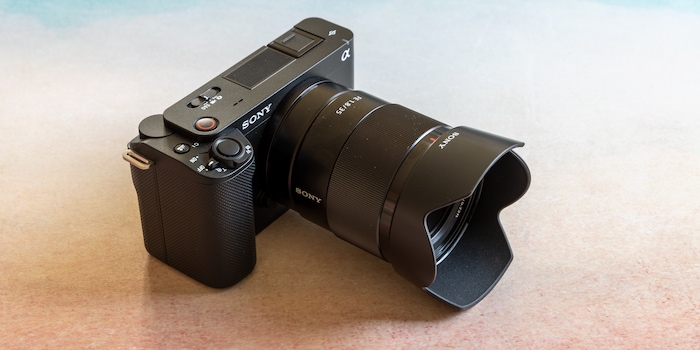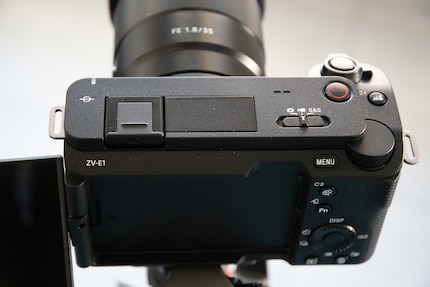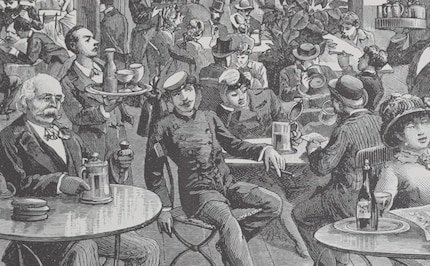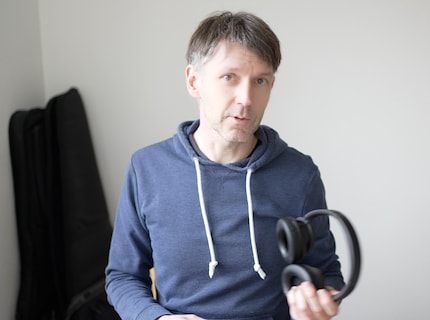

Sony ZV-E1: High-quality video camera with easy operation
The Sony ZV-E1 full-frame camera combines a beginner-friendly concept with high quality. The new functions include an image stabiliser, the effectiveness of which I have already been able to see for myself.
The Sony ZV-E1 is aimed at people who want to produce videos quickly and easily. Although it can also take photos, it is not primarily designed for this purpose. This is why Sony also refers to the device as a vlogging camera. Although very few buyers will probably create a vlog - i.e. a video diary - the type of production is likely to be similar for travel videos or other occasions.
All cameras in the ZV series are vlogging cameras in this sense. The series began with the compact camera ZV-1, followed by the APS-C camera ZV-E10, and now the ZV-E1 - a full-frame camera. It offers the same features as the existing ZV cameras plus a few new ones. And of course higher image quality.

The most important key data
The sensor of the ZV-E1 has a resolution of 12 megapixels. This is not enough for taking photos, but it is sufficient for 4K videos. A lower pixel count can even be an advantage. Because it means that less maths has to be done. In addition, the individual pixels are nice and large, which has a positive effect on the image quality.
The body is very light and compact for a full-frame camera. It weighs 483 grams and measures 121 × 72 × 54 millimetres. This is also due to the fact that it has no viewfinder. On the top is an array with three microphones that can pick up sound from all sides. A windscreen can be attached to this. The camera has a zoom rocker and a red light that shows you from the front whether recording is in progress. And, of course, a dedicated video recording button. The screen can be folded out and rotated 180 degrees. None of this is new, but is also available in the previously released ZV cameras.

Source: David Lee
The video capabilities of the newcomer go far beyond those of other ZV cameras. 4:2:2 scanning and 10-bit colour depth are available, as are the S-Cinetone and S-Log 3 colour profiles, as well as advanced features such as Zebra display or Focus Mapping.
The ZV-E1 can currently record 4K with up to 60 frames per second (FPS), Full HD with up to 120 FPS. Sony has announced a firmware update that will double these values: up to 120 FPS in 4K and 240 FPS in Full HD.
With the ZV-E1, you also get top autofocus: Sony cameras are leaders in scene recognition and this camera is at the cutting edge of Sony's development.
Differences to the Alpha 7S III and the FX3
Sony now has several full-frame cameras with powerful video functions on sale. The Alpha 7S III and FX3 in particular have a lot in common with the ZV-E1, such as the sensor and, following the promised update for the ZV-E1, the maximum frame rate. So what's the difference?
The Alpha 7S III is a hybrid camera: photography is just as important as video. That's why this camera offers the familiar controls that are practical for photography: for example, a wheel for the exposure mode or for exposure compensation. Or a joystick with which you can quickly move the focus. And above all, you have a viewfinder.
The FX3, like the ZV-E1, is designed for video production. Neither camera is particularly practical for taking photos. The difference between the FX3 and the ZV-E1 is that the FX3 is intended for professional and elaborate video production. For example, it has threads for installation in a rig and an audio handle for connecting XLR microphones. Buttons are labelled "Zebra" or "Peaking". This can be quite daunting for beginners.
The ZV-E1, on the other hand, is designed for simpler video operation. The controls are video-centred, but you will understand most of them even if you are not a professional video producer. There are also the typical video aids of the ZV series. Some of these are new to the ZV-E1.
Aside from the orientation, the three cameras also differ in price. The ZV-E1 costs only half as much as the FX3 and is also significantly cheaper than the A7S III. Even though the FX3 is protected from overheating with an air-cooled housing, it seems a little too expensive in comparison. And with the Alpha 7S III, the question arises as to whether a hybrid camera with only 12 megapixels is still worth well over 3,000 francs these days.
The new ZV features
A new function is auto-framing. The camera digitally zooms into the image and enlarges a selected motif. You can choose between three crop sizes. The funny thing about it: if the subject moves in the picture, the frame moves with it. When you stop tracking, the camera zooms out again. This may save you time-consuming post-processing with keyframes. After trying it out briefly, I can't say whether it is useful in reality.
The low resolution of the camera is a problem with this feature. With 12 megapixels, you don't have much room for manoeuvre with 4K: almost the entire sensor has to be used to achieve the required resolution. As a result, there is no longer enough room for true 4K when zooming in. At the highest zoom level, you can clearly see the loss of resolution. In the following comparison, I shot the same subject twice with the same image section. Once normally and once with auto-framing. The auto-framed shot is much less sharp. I have enlarged a section of the image in each case for clarity.

Source: David Lee
A new image stabiliser also works with frames. It compensates for unsteady hand movements much better than the previous image stabilisation systems from Sony. The ZV-E1 also offers the "SteadyShot Dynamic Active" stabiliser, which is also very good. And also new.
In a test run, my colleague Samuel Buchmann films me as he walks alongside me. You can see the following shots one after the other:
- Standard Steadyshot (optical image stabilisation only)
- Active Steadyshot (optical and electronic image stabilisation)
- Dynamic Active Steadyshot (optical and aggressive electronic image stabilisation)
- Frame stabiliser (optical and even more aggressive electronic image stabilisation)
The two new stabiliser methods result in a strong crop. The frame stabiliser is even stronger than the Dynamic Active Steadyshot. You can't see this here because we have adjusted the crop with the zoom lens.
The digital narrowing of the image section reduces the resolution in exactly the same way as with auto-framing. The function is therefore no substitute for a gimbal. If you don't have one to hand, it is still a help: a steady video with less resolution is better than a shaky recording.
Another new feature: if a second person enters the picture, the camera can extend the depth of field so that both people are in focus. I have not tried this out.
The familiar ZV features
In product presentation mode, the camera automatically focuses on an object that you hold up to the camera. This is nothing new in the ZV range, but in full-frame the effect is stronger because you can create more depth of field. I tried this here with aperture f/1.8.
The defocus switches between large and small depth of field at the touch of a button. The aperture is simply opened or closed. This effect is also greater in full format.
The soft skin effect smoothes the skin. This was already available on the ZV-1, but didn't convince me at the time because the wrinkles were suddenly visible on the face again.
I think the effect is a little better with the ZV-E1. The changes between wrinkled and smooth faces only occur occasionally and are less noticeable. Nevertheless, I would only use the effect discreetly on the low setting. In addition to the temporary skin wrinkles, the lack of sharpness is also distracting. It looks a little as if my face is not in focus.

Source: David Lee
First assessment
I have always wondered why practical features such as presentation mode are not also found in high-quality cameras. With the ZV-E1, this becomes a fact. It's not like you want the most complicated operation possible just so you can feel like a professional.
I'm not sure if all the features will be useful in real projects. Auto-framing has potential, but I would have to test it more thoroughly. In addition, this function would make much more sense with a higher resolution. I would use the soft skin effect discreetly at most, even if it works better now than with the ZV-1. Make-up is still better for minimising wrinkles in front of the camera. And I personally don't mind at all if my wrinkles are visible.
You shouldn't be fooled by such gimmicks either: The basic quality of this camera is very solid. As usual with Sony, the autofocus is top-notch. The vlogging features are on top. And at a lower price than the previous full-format video cameras. I think the concept of the ZV-E1 is cool and believe that it will find its customers.
My interest in IT and writing landed me in tech journalism early on (2000). I want to know how we can use technology without being used. Outside of the office, I’m a keen musician who makes up for lacking talent with excessive enthusiasm.
From the latest iPhone to the return of 80s fashion. The editorial team will help you make sense of it all.
Show all
